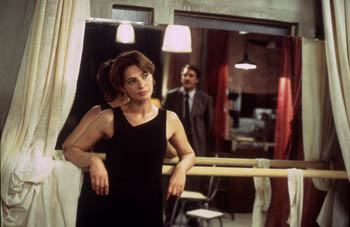![[Metroactive Movies]](/movies/gifs/movies468.gif)
[ Movies Index | Show Times | Silicon Valley | Metroactive Home | Archives ]
Marxist Brothers
John Malkovich's 'The Dancer Upstairs' takes a post-revolutionary look at revolution
By Richard von Busack
SAY WHAT you will about the Sendero Luminoso, but at least it was clear what the group stood for. Peru's Sendero Luminoso, a.k.a. the Shining Path, was Latin America's most deadly cadre of rebels. John Malkovich's debut as a director, The Dancer Upstairs, is an arcane political suspense film based on Nicholas Shakespeare's novel. Although Shakespeare modeled the rebels in The Dancer Upstairs on the Shining Path, they seem imaginary, too. With their mottoes--some Maoist, some Nazi--they resemble a band of Situationalists on the warpath.
Javier Bardem plays Agustin Rejas, a police detective disliked by his superiors and rarely paid by the tottering government. He is in charge of the civilian investigation of the revolutionaries, who are led by the mysterious "Presidente Ezequiel." This dropped-out lawyer and a natural philosopher is a bemused man. He's untroubled that his wife has a more serious relationship with Vogue en Español magazine than she has with him. During the almost impossible search for the rebels, Rejas begins to notice his daughter's ballet teacher, Yolanda (Laura Morante). A shy flirtation starts--a liaison we can presume will not go unnoticed by Ezequiel and his men. Bardem, who sports some of the heaviest eyelids since Victor Mature, possesses an old-time movie star's easiness. It's nice to have a break from the stereotype of the dogged cop, but Rejas seems a little underwhelmed by the fact that his country's blowing up.
All fans of Malkovich's acting will guess that his interests aren't with this pussyfooting cop but with the mad rebels, with their intensity and bold gestures. Running amok, leaving dead dogs, torn bodies and scrawled slogans behind, they're so omnipresent it's as if no one notices them. At night, the rebels shoot off fireworks, apparently to mock the police. In a routine possibly inspired by Johnny Depp's heart-of-darkness train ride in the beginning of Dead Man, the farther Rejas travels into the mountains the more extravagantly the local Indians praise the mysterious Ezequiel.
Yet The Dancer Upstairs is a post-Marxist movie; it's distant from the revolutionary fervor and thus seems numb and strange. Like many stage directors turned filmmakers, Malkovich tends to neglect motivation, trusting in the text to provide the atmosphere. In live theater, it's enough to say, "This is Illyria, lady," but in a movie you need some Illyrians. Telling us that a couple are beginning to fall in love is one thing, but Yolanda and Agustin seem scarcely to have noticed one another even by the time they're becoming intimate. One of the major technical failures in the film is a disorienting crosscut between a theater attacked by terrorists and a kid's ballet recital; it takes a minute to realize we're seeing two separate auditoriums. The film's soundtrack intro and outro is the late, lamented Nina Simone blood-chilling cover of "Who Knows Where the Time Goes?" Powerful music (and Simone's death is a major loss); still, there's nothing that hits the emotions in The Dancer Upstairs half as well as this dirge.
[ Silicon Valley | Metroactive Home | Archives ]
![]()

Shining Examples: Laura Morante and Javier Bardem tangle with a mysterious rebel leader in 'The Dancer Upstairs.'
The Dancer Upstairs (R; 129 min.), directed by John Malkovich, written by Nicholas Shakespeare, photographed by José Luis Alcaine and starring Javier Bardem and Laura Morante, opens Friday at Camera 7 Pruneyard in Campbell.
Send a letter to the editor about this story to letters@metronews.com.
From the May 8-14, 2003 issue of Metro, Silicon Valley's Weekly Newspaper.